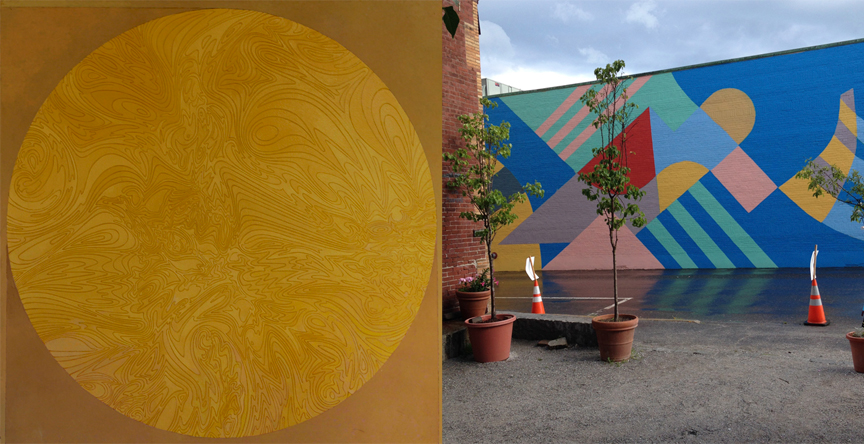Richard Iammarino
(painter, sculptor, father)
&
Alexis Iammarino
(painter, dancer, daughter)
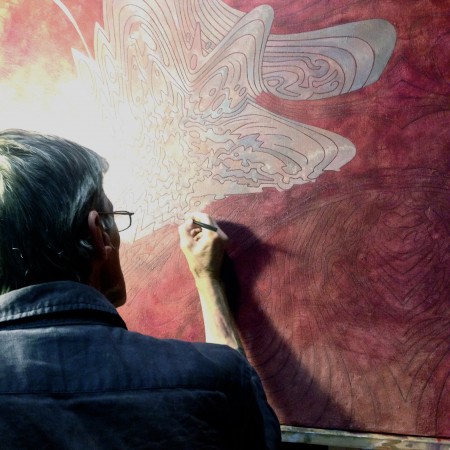
When referring to Richard Iammarino, one could be forgiven for employing the bankrupt metaphor that here is an artist born with paintbrush in hand: at the ripe age of seven years old, Richard enrolled in his first art classes and workshops at the Cleveland Institute of Art, the same school where — after a three-year stint in the Army, as he puts it, “jumping out of airplanes” — he later earned his degree in studio art. That was in 1962. Since then, Richard has traveled, worked, and lived in varying bohemian degrees, from India to Italy, Brazil to Haight-Ashbury. His constant companion throughout the decades has been his art: silver-pencil drawings, ornate wood carvings, enormous and hypnotizing paintings. Now in his late seventies, Richard has settled into a new chapter of his life in Rockland, where already in his brief Maine tenure he’s had two solo shows (at Asymmetrick Arts and Win Wilder Hall) and taken part in two group shows (again at Asymmetrick Arts, and also as a part of the Royal Open, documented in Issue 1 of The Chart). There’s also been talk of Richard co-curating a winter film series. So it would seem his new home has welcomed him warmly.
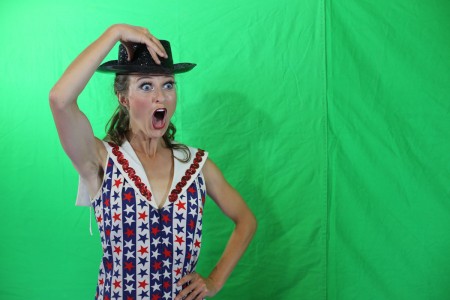
In the case of Richard’s daughter, Alexis Iammarino, the aforementioned cliché is almost an empirical fact. Born into a household of working artists (in addition to her father, Alexis’s mother and brother are both accomplished creative forces in their own right), it would have been a feat for her not to become an artist. Studying studio art and dance at Goucher and later garnering a masters in community arts from Maryland Institute College of Art, Alexis has devoted her entire life — on levels both conscious and intuitive — to making and teaching art, from the undulating weirdness of her private journals and letters, to her large scale public works, to her role as assistant producer/cinematographer/choreographer/et alia in Misha Capecchi’s experimental spaghetti western In the Mouth of the Wolf (currently in production). In her recent years living and working in Maine, Alexis has engaged in several collaborative community arts projects, including five public murals as well as Follow the Shirts, a recurring quarter-mile-long installation (in collaboration with sculptor Andrew White as well as countless mid-coast volunteers) involving roughly 450 shirts stitched together cuff-to-cuff and strung through the streets and yards of Rockland. Her most recent mural (a collaboration with Baltimore artist duo Jessie Unterhalter and Katey Truhn, as part of the Farnsworth Museum’s Mural Arts Program) spans the entire side of the Planet Toys Building on Oak Street in Rockland. Coincidentally, Alexis’s father lives next door to this expansive, vibrant painting.
On the sultry September afternoon of our conversation, I met Alexis and her husband, Scott Sell, at their Main Street apartment. We ate a snack of cabbage salad and peanut buttered apples while admiring their tuxedo-cat, Denny, then walked the few blocks to Richard’s studio, where we found him reading a book on the partitioning of India. Amid a bower of Richard’s countless stacked and hanging paintings, we discussed improvisation, compulsion, and decapitation-as-art-form, while in the adjoining kitchen, Scott cooked up some supper. Afterward, we took our bowls of steaming pasta outside to eat at a picnic table facing Alexis’s recent mural. Some kitchen workers on their smoke break stood dwarfed beneath its magnitude. In the evening’s warm wash of streetlight, the mural’s primary blues and yellows were positively radiant. Richard later admitted, he often takes his meals in this very spot just so he can look on admiringly at his daughter’s latest work.
— Douglas W. Milliken
On Spontaneity
Douglas W. Milliken: I think just to start off, and I know you guys will take it from here, but to start I’d like each of you to describe the other as an artist. I guess you could describe each other as people as well.
Richard Iammarino: I thought about this, because you called last night, and I was trying to think of the similarities between us, but more importantly, the differences. Alexis is much more spontaneous than myself. I’m very meticulous. I gotta get it right. She just whips it out and moves on to the next one, just like that, and I think that’s a wonderful quality. I wish I had it. I have it sometimes. When I was younger, maybe. But as I move along through this art career, I get more and more…precise. I perfect everything. And it takes years to do it. With Alexis, it happens, it’s finished, and she’s on to the next thing. That’s how I read her work. And it’s always been that way.
DWM: Alexis, does that jive with your understanding of yourself?
Alexis Iammarino: I am very spontaneous, that is true. But I guess where I am less spontaneous is my level of wanting a technique to be done right or wanting the integrity of something to last. So yes, my designs are totally spontaneous, and tend I do all my comics and journals and the stuff I actually do on a daily basis just as he describes, it’s totally spontaneous, it’s off the cuff. But when I’m doing larger art projects or the big wash paintings that I do, they feel very precise.
RI: I’m thinking mainly of the letters and your journals and things like that. Sometimes you go through those journals and see the letters and they’re really off the wall. I suppose they’re coming from somewhere specific but they seem almost random.
AI: I think when I used to read a lot, my journals or sketches or the more free-associative stuff was really informed by a lot of reading.
RI: What kind of reading?
AI: Like all the books you lent me.
RI: [laughing] Oh! Oh! That stuff. The Painted Bird by Jerzy Kosinski or something.
AI: No, it was like — I’m thinking, in college you gave me King Leopold’s Ghost, you gave me Heart of Darkness.
RI: Yeah, I do have a tendency to look at the [sighs] at that aspect, I guess. Genocide and all that. And I know at that time I was reading a lot of those things.
AI: I actually do have a bibliography. I used to read so much in college, and certainly in graduate school. They were always razzing me for showing up to discussion classes with, like, a cart of books, and I would just have everything annotated. I’m a collector and keeper, so the drawings are very spontaneous but I think they’re probably lucid representations of fleeting things that I read about, or thought, “Oh, the best way to describe that particular political power is ‘Erect Penis Through Donut.’”
DWM: I think the thing that I’m getting about Alexis’s work is that it feels spontaneous. It’s all this technique and time and work put into something so that it looks spontaneous and in execution, it’s done very quickly or seemingly quickly.
AI: I think my greatest attribute and strength is, I am a very good improviser. And that definitely comes out of the dance, but it’s exactly as you say.
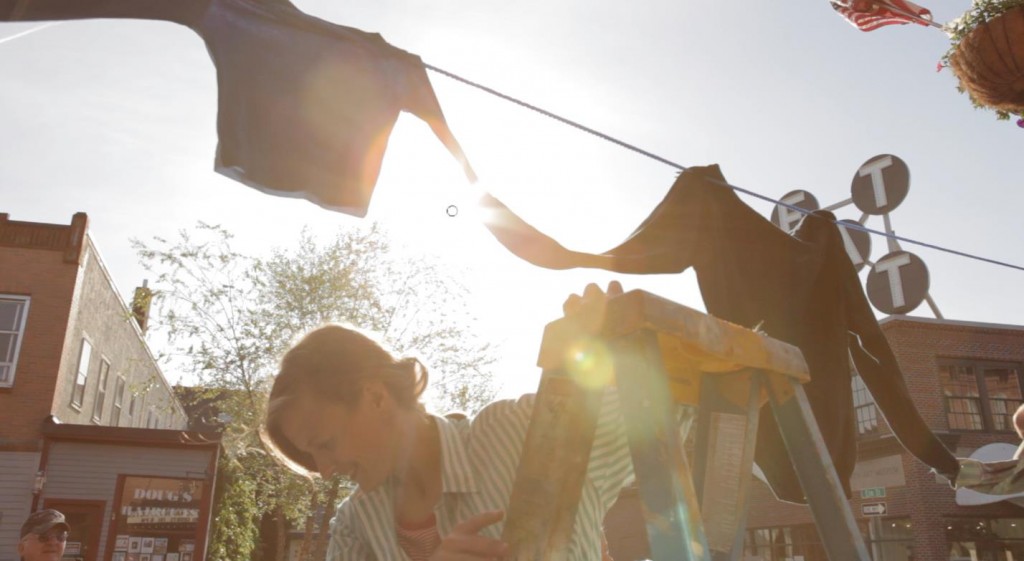
DWM: Meanwhile, Richard, in your paintings, while no one would really look at them and immediately think of spontaneity or improvisation, the lines aren’t solid, they’re gradients, the colors are continually moving. The color fields aren’t fields, their texture. There is a visceral movement.
RI: The paintings I’m doing now over the past six years, the original drawings are very spontaneous. I draw them on a scale like this [holds up his hands to make a square roughly the size of a Kit Kat]. I do a lot of them, but they aren’t…labored, they’re really quite spontaneous. Then I grid them up and I lay them down exactly. In other words, it’s almost against spontaneity. You take this spontaneous drawing and you put it on a canvas and spend six months coloring this spontaneous piece that was originally four-by-four inches. There is a spontaneity to them, I guess, but no, the execution? I’m still dealing with the execution. In fact, this is as close as I’ve come to what I really want, and this is six years later. I’m ready to rework all of these pictures that I did over the past six years because I finally have come to the marks I think describe what I want these things to look like. There’s a drawing over there that I spent three months on. And I think that’s the difference between Alexis and I, I think, in that I don’t think that you could spent three months on a piece, or could you?
AI: I think I will. And I think I used to. I think the kinds of things where time is manifest is in the months of coordinating and planning. And if it’s not an influence of dance, I chose dance because I like being in community, I like being in concert with others. With the murals I’ve been doing the last few years or the programs I do with students, the meticulousness is in the planning and the building of the experience. The artwork in the end, the way people are describing what they see at the end of a project, they’re like “Oh, that looks so lively” or whatever words they’re using. Dynamic or it’s colorful or it’s fun or it’s vibrant. That’s because the project is hopefully designed to include the energy of every person involved. So it’s like the coordinating and bringing other people in that is six months in the works. It’s more like orchestration.
RI: I was going to say, you’re like an organizer. It was pretty tough to pull that whole thing together out there. It wasn’t just painting the wall. It was months of work. It’s a different six months.
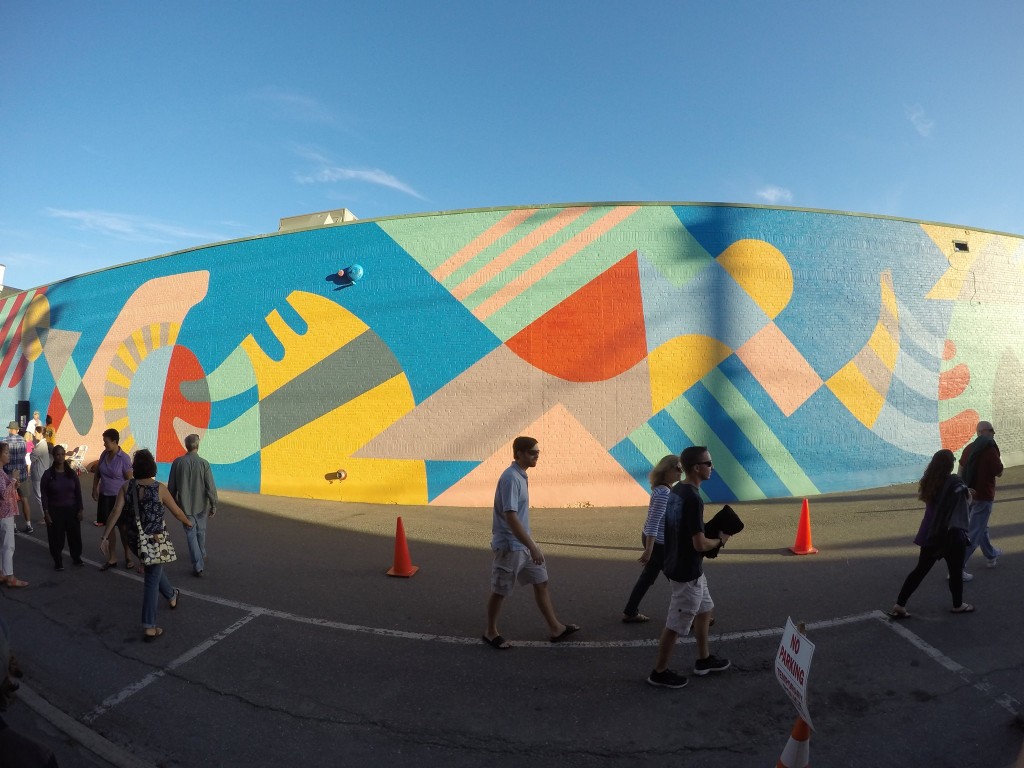
On Mastery and Discipline
DWM: Richard, when I think of your work, I think of not just these gigantic, beautiful, very saturated abstract paintings, but also your drawings and your sculptures. And Alexis, I probably think of you more as a dancer first and foremost, but the more I think about this, you have this — how big is the mural?
AI: It’s 134 feet by 20 feet.
DWM: That’s a massive painting. Then your shirt project. So clearly there’s not one particular discipline that either of you is really—
RI: That’s a good point.
DWM: So how do you see yourselves or each other?
AI: Well, I was going to say—because it’s true that maybe I am more spontaneous than you are now, or it could refer to: you were more spontaneous in other times or something—
RI: [laughs] Yeah, I’m talking about now.
AI: You know, you’re seventy-eight years old. I’m thirty-two years old. I think, not only describing my dad but when I describe the work that my mom and Sandy [Alexis’s step-father] do for work, what my brother does for work, it’s very much about the mastery with which people know what it is they’re doing. It doesn’t matter what they’re doing, but they seem to really know how to do it quite well. So I, even though I’m a spontaneous maker, the technique is important to me. But that totally comes out of the discipline of dance, and the discipline of ballet in particular.
RI: That’s a good point. The ballet as opposed to spontaneity, I guess, because ballet is not spontaneity at all, is it? Or is it?
AI: It is, actually. You have to train enough within a particular series of exercises ‘til you get well enough at it—
RI: But there is a right way.
AI: There is. And it depends on the syllabus you study. But I would describe Dad’s work similarly, in the same way that, when I introduce myself to people, I’m like, “It really depends on who I’m collaborating with, that’s kind of the art that I’ll be doing.” And Dad doesn’t really do a lot of collaborative work, but he’ll go on a trajectory of, like, the paintings for six months, but he’s got to take a break every fifteen minutes or however long you do. So you’ll paint for an hour and then you’ll carve for thirty minutes. So it’s like you’re always changing modalities but there’s skill every step of the way.
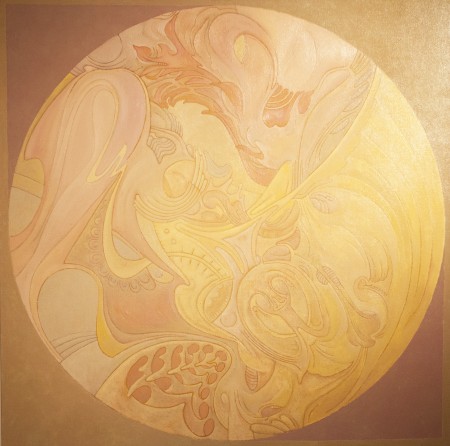
RI: I really like that idea of being not just a painter, though I don’t dance or anything like that, obvious. The carving, the cartoons of all things have probably less to do with the stuff than anything. But I enjoy that just as much as I do making that painting [gestures to a new painting made up almost entirely of deep shades of earthy red] or doing the carving. I can jump from one to the other and feel quite comfortable, and in fact I like that idea of moving around. I used to think, all you had to do was point me toward a medium and I’ll do something with it, it could be a printing press, anything, a block of ebony. It’s all the same to me. Just grab it and do something with it. So yeah, I’m all over the place in many ways, but I don’t prefer one to the other. They all are the same in terms of interest.
AI: Me too.
RI: To be just a painter…is okay, I guess.
AI: Capital P is hard.
On Compulsion
AI: Recently, I’ve been thinking about what people see. Because I know his work so well, and I grew up steeped in all of these objects that are all around us and the paintings that are stacked up, there are things that I know so intimately, I recognize them from when I was little. But people here [in Rockland], when they come up here, they are really confronting, like, “Oh, this is what it really looks like to work for sixty-some-odd years.” And it’s not like you saved everything you ever made, you probably lost a fair amount along the way.
RI: Quite a few, yeah. It just goes into the ozone or people get it or it disappears.
AI: But I would describe him as, it’s being an artist compulsively. You’re not saying, “Well, today, I think I’d like to do this.” I think he would describe my brother Tony similarly. You just got to wake up and draw. Tony would wake up, he’d smoke a bunch of cigarettes, he’d have his coffee, and he’d sit and draw. And a number of people have had that experience of needing to get to some quick, concentrated zone, but it’s not some sort of choice that you make. At a certain point, you’re either a very disciplined individual, or you’re totally compulsive.
RI: It’s both, I think. I’ve thought about that a lot over the years, what makes a person an artist, a writer, whatever they’re doing. And it is a compulsion. It isn’t something you try to do or that you work toward, it just is. You do it. You draw. It is a compulsion, it’s a good word, I think. It’s almost not learned. Tony’s a natural, isn’t he?
AI: He is. But he’s also obsessive and compulsive in whatever he does in the same way that I tend to be fairly meticulous in executing something. So in a way, if I hadn’t been raised in a family of artists, I wonder if I would be so artistic, or if I was raised in a very industrious family that did something else, I would just be industrious in the same way. When I was younger I felt like the thing I didn’t need to work so hard at was self-expression, I could always sort of wrangle that out in some way, whether it was the weird clothing or the hair-dos or emulating 60s pop people. I loved Janis Joplin. I had this whole psychedelic phase of my third- and fourth-grade life. But when I sat down to make art, I didn’t have to work so hard at expressing myself or making myself understood. Yet I struggled with writing and more linear things. So it’s what you get support with, or also what you have a better respect for yourself already. I think I respected myself being creative more than a lot of people because I didn’t feel so confident with writing or other things.
On the Politics of the A-Word
AI: I’m always wrestling, when I’m doing credits for the projects I do, I really struggle with a word like “student.” I’d really just rather call them “youth-artists” because that’s what they really are. When they’re engaged in this project with me and when they’re making art week after week, day after day, they are actually engaged in art practice.
RI: It’s kind of tricky. I remember, I actually put “artist” as my occupation one time on my driver’s license, and I said, “What an arrogant jerk you are!” That was my occupation? C’mon!
DWM: Do you feel more comfortable with calling yourself an artist now?
RI: No. It’s something I think about a lot. If someone asks me what I do, I paint pictures, or I carve sculptures. I don’t like to add that other element. I had a friend in San Francisco, a good friend, and out there I was making all kinds of stuff, little dope pipes and stuff like that, and when she introduced me, she always said, “This is my friend Richard, he makes beautiful things.” She didn’t say, “He’s an artist.” She said, “He makes beautiful things.” And I thought, that’s more like it. I like that idea better. “He makes beautiful things.” Just describe the activity rather than put it on that pedestal like Michelangelo or Leonardo. I don’t know how you make that distinction, but Leonardo and I are not on the same plane, believe me.
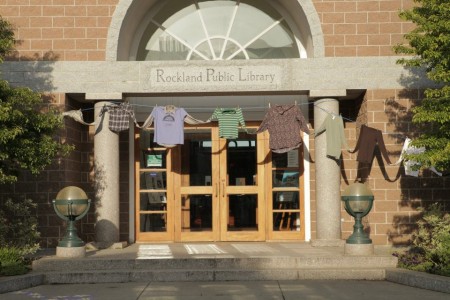
AI: But when kids are learning art, you could sort of reinforce that same hierarchy by saying, “You’re students, you’re still a student, you’re students, you’re still a student.” And of course, there are things that I am teaching them, but because I work with so many people outside of a school situation, I am like, “You are not in school right now, you are working with an artist, you are working with me who lives life as an artist, as a teaching-artist at that.” So that’s what makes it matter to me that they are not called students, that they’re not just called passersby, because they’re hanging out with artists, they’re keeping company with artists over the course of a project, they’re part of the community or club of artists. I don’t want to say, “I’m the artist and you’re the student.” I would rather say, “we’re making art together, so we’re artists.” Even if it’s for a finite amount of time. I feel better giving them that title, even if it’s not with a Capital A. If we’re going to shoot hoops, we’re going to play basketball, we’ll be basketball players for the day. […] The style in which I make art is very much like I do with my family or for my friends. I try to commit the same level of care [when I work with family and friends] as when I design a project with the schools or the rec or the library. It could be a flawed level of care or concern for how well a project will go, and to make people feel included or valued, but that’s because I wouldn’t be lousy to my sister or you or my dad. I don’t see it as unprofessional. It’s like decency. It’s decency for all. […] I think we’re saying similar things, but I intentionally call them artists maybe for the same reasons that you think it’s silly for everyone to call themselves artists.
RI: But on the other hand, if everyone’s an artist, what a wonderful world. Everyone’s making art. It’s better than killing one another or chopping off heads.
AI: You could be an artist who wants to cut people’s heads off and put them on spikes.
RI: That’s true, that’s true, if you want to do it right.
AI: But I hope not.
On Collaboration and Influence
RI: Remember when we used to do those “You Draw, I Draw” things when you were a little kid?
AI: Mmm-hmm.
RI: We’d make marks on the paper and then we’d elaborate on them, we had no idea where it was going, and I remember that so well, she was five years old, six years old. I did it with Tony, too. It was terrific. And we were doing collaborative art even at that time, how many years ago was that? Thirty years ago, I guess.
AI: That was my first slide in my Pecha Kucha presentation. “The collaboration starts here.” It sounds more academic or silly, but when asked to describe the idiom of how I work, I say, “It was kind of familial,” or “it was collaborative,” because the people I grew up with, yeah, parents, siblings, friends, whoever, yeah, we did make art, but it wasn’t some rarefied activity.
DWM: I think it’s pretty well established that in various ways, Alexis, your father has influenced your work or has influenced you to make work. I wonder, Richard, if that ever cycles back around and Alexis influences your work and process.
RI: Oh, I think for sure, of course. I’ve always watched what she’s doing. The difference is, with Alexis—and I’ll go back to that spontaneity thing—I’ve always admired and I almost try to emulate sometimes her bravery with color. I don’t have that bravery with color. I even start out with it sometimes but I always end up with what you see [gestures again to his dark, earthy red painting]. So in that sense, I do, I look at her work and I envy her ability to use color so freely and without any inhibitions and I guess that comes from her dance. Dance has a lot to do with this idea of spontaneity because when you’re a dancer, you’re on a stage, and you just go nuts, who cares, go nuts. I don’t have that. And I envy that a lot. In many ways, as radical as I like to think I am, I’m pretty conservative. The way I dress, the way I work, the way I think. I’ll go out and jump off a cliff or something, but at the same time, I’ve very very conservative, and she isn’t, and that’s something I envy a lot, that thing you seem to have, you do have.
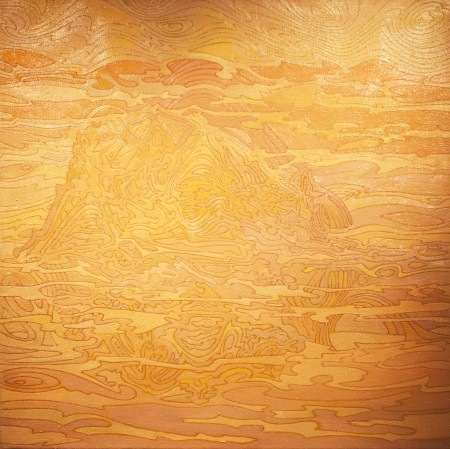
AI: A year ago when he moved up here, he hadn’t even unpacked and was showing up in the rec every day to work on the mural that I was doing over there, which was really the first painting on that scale that I had done, and that was very interesting as it was probably the first time that you were working with me on a project as an adult. We’d done jobs together, but in terms of my being an adult artist in this small town that Scott and I call home, it was very interesting because there were things that you were seeing in how I work or engage with students or youth. You hadn’t really seen me in action. You hadn’t seen me leading. I think, as well as you do know me, I wonder how well you know me as an educator or a facilitator. Now you know maybe what it’s like to be involved in a project with me.
RI: That’s a whole other conversation.
AI: It is a whole other conversation. But I think that is kind of interesting, because there are things that I teach people that I was taught by you or Mom. But not in the way that you would facilitate in any way, because we have slightly different pedagogy or philosophy around that sort of stuff.
RI: Well, you’re a teacher. I’m not a teacher.
AI: But you are a teacher.
RI: No, I’m not.
You can see more of Alexis Iammarino’s work at http://www.alexisiammarino.com/. For more of Richard Iammarino’s work, visit his page the Asymmetrick Arts site at http://www.asymmetrickarts.com/exhibition/richard-iammarino%3A-new-works.
Douglas W. Milliken is the author of the novel To Sleep as Animals and several chapbooks, most recently the collection Cream River and the pocket-sized edition One Thousand Owls Behind Your Chest. His stories have been honored by the Maine Literary Awards, the Pushcart Prize anthology, and Glimmer Train Stories, and have been published in Slice, the Collagist, and the Believer, among others.

